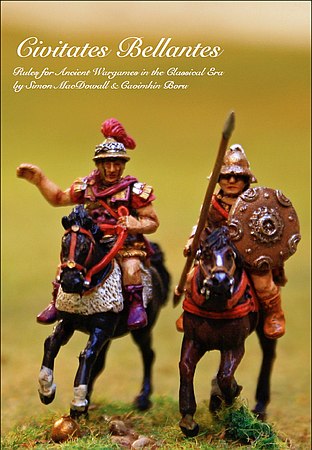
Civitates Bellantes
Civitates Bellantes is a set of rules which simulate warfare in Europe, the near East and Mediterranean from the fourth century BC to the third century AD. The rules are suitable for games with miniature figures in all scales from 2mm to 30mm. Although primarily designed with the Macedonian and Punic wars in mind, the mechanisms can be used for the earlier Greek and Persian conflicts as well as the rise of Imperial Rome.
Although these rules are designed around the same principles as Comitatus, they also have unique features which capture the flavour of the period. Particular attention has been given to developing practical ways to reflect the relative strengths and weaknesses of the phalanx, the legion and their supporting arms.
– publisher's listing
- Designers
- Simon MacDowell, Caoimhin Boru
- Publisher
- Legio Wargames
- Year Published
- 2012
- Status
- In Print
- Contents
- Available online (PDF)
- Basing
Stand size is not critical, so long as all the stand frontages are the same in both armies. To conform to most current ancient wargames rules, the following stand sizes are recommended:
| Scale of Figures | Stand Size |
|---|
| Frontage | Depth |
|---|
| 6mm | 20mm | 20mm |
| 15mm | 40mm | 30mm |
| 25mm | 60mm | 40mm |
Players using 20mm figures may use either the 15mm or 25mm scale for basing and ranges, reducing or increasing the number of figures per stand to fit.
For 6mm scale figures players can use the 20mm square stands, or alternatively use 40mm stands but increase the number of figures. The same is true for 10mm or 2mm figures.
– Civitates Bellantes page 11
Back to RULES DIRECTORY
Areas of InterestAncients
Featured Hobby News Article
Featured Recent Link
Featured Ruleset
Featured Showcase Article More figures for the 28mm Amazon army!
Featured Workbench Article The Army for Bill was a collective project in which TMP'ers came together to jointly paint an Ancients army for yours truly.
Featured Book Review
|
Rules for Ancient Wargames in the Classical Era
|










 (6.28)
(6.28)
![]() Editor in Chief Bill
Editor in Chief Bill ![]()
![]() on 21 November 2016. Last revised by
on 21 November 2016. Last revised by ![]() Editor in Chief Bill
Editor in Chief Bill ![]()
![]() on 21 November 2016.
on 21 November 2016.